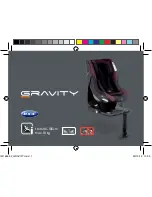
warning
2
Warnings
....................................................... 3–4
Safety Information
............................................ 5
Features
......................................................... 6–7
Using the Restraint
........................................... 8
. Secure.Your.Child.in.the.Restraint............. 8–9
. Reclined.Position......................................... 10
. Upright.Position.......................................... 11
. Check.Harness.Height................................. 12
. Harness.Height.Adjustment......................... 13
Vehicle Safety Belts
......................................... 14
Vehicle Seating Positions
................................ 15
Rear-Facing Installation
.................................. 16
. LATCH.Installation.and.Removal........... 16–17
. Locking.Lap-Shoulder.Belt.Installation..... 18–19
. Non-Locking.ELR.Lap-Shoulder.Belt..
. ....Installation.Using.a.Locking.Clip....... 20–21
. Lap.Belt.Installation............................... 22–23
Forward-Facing Installation
............................ 24
. LATCH.Installation.and.Removal........... 24–25
. Locking.Lap-Shoulder.Belt.Installation........... 26.
. Non-Locking.ELR.Lap-Shoulder.Belt..
. ....Installation.Using.a.Locking.Clip....... 27–28
. Lap.Belt.Installation..................................... 29
3
• Use rear-facing position when using restraint with an infant weighing
20 pounds (9 kg) or less. The American Academy of Pediatrics
recommends rear-facing until at least 1 year of age and 20 pounds.
• Use only with children who weigh between 5 and 55 pounds (2.3 and
25 kg) and whose height is 49 inches (124 cm) or less. Rear-facing
5-33 pounds (2.3-15 kg) and forward-facing maximum 55 pounds
(25 kg).
• Snugly adjust the belts provided with this child restraint around your
child. A snug strap should not allow any slack. It lies in a relatively
straight line without sagging. It does not press on the child’s flesh or
push the child’s body into an unnatural position.
• Secure the top anchorage strap (tether) provided with this child restraint.
• Secure this child restraint with the vehicle’s child restraint anchorage
system (LATCH) if available or with a vehicle belt.
• Follow all instructions on this child restraint and in the written
instructions stored under cover at front of seat.
• Register your child restraint with the manufacturer.
• This child restraint must not be used in the home, in boats, or other
non-certified applications.
• Use vehicle belt (not lower connectors) for installations with children
weighing more than 48 pounds (21 kg). Refer to the vehicle owner’s
manual or contact the vehicle manufacturer for the maximum weight
rating for their lower anchors. Unless specified otherwise by the
vehicle manufacturer, assume a 48-pound child is the vehicle lower
anchor limit.
Check Buckle Position
..................................... 30
Installation in Aircraft
...................................... 31
. Rear-Facing.Installation................................ 31
. Forward-Facing.Installation......................... 31
Using the Tether
........................................ 32–33
Care and Maintenance
.................................. 34
. Cover.Removal.and.Replacement............... 34
. Cleaning.the.Cover,.Shell.and.Harness.
. ....and.Harness.Adjuster............................... 35
. Buckle.Removal.and.Replacement.............. 36
. Cleaning.the.Buckle..................................... 37
Warranty
......................................................... 38
Safety Information
Fisher-Price.and.related.trademarks.and.copyrights.are.used.under.license.from.
Fisher-Price,.Inc.,.a.subsidiary.of.Mattel,.Inc.,.East.Aurora,.NY.14052..U.S.A..©2006.
Mattel,.Inc..All.Rights.Reserved..MADE.IN.U.S.A...
Manufactured.for.and.distributed.by.a.subsidiary.of:
Britax.Childcare.Limited
P266700
R1.01.06



































